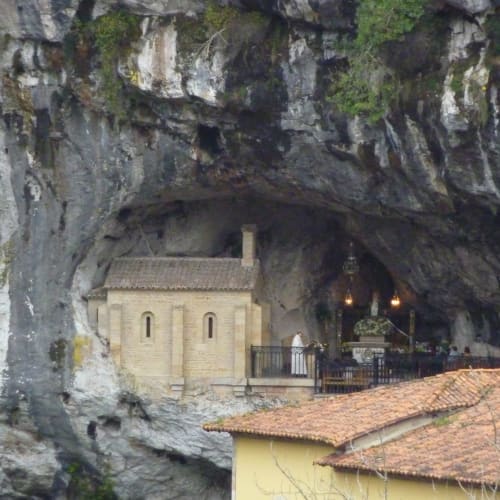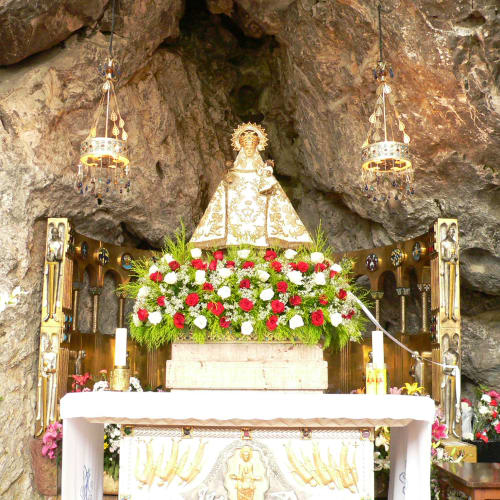Covadonga, Tales of War and Cheese
April 2010




For just a brief moment, all of Spain was focused on a deep valley in the dramatic Picos de Europa, bounded by almost vertical canyon walls. Like a shooting star, events in the bucolic valley of Covadonga and the village of Cangas de Onis flashed across the sky, and after a few dramatic years returned to a place where shepherds tend their flocks and make cheeses.
The fabled Battle of Covadonga was where, under the leadership of the legendary Don Pelayo, brave Asturian mountain men halted the inexorable advance of the Muslim forces. Had the Asturians lost, the Christians would have been pushed into the sea, for they were located but a few miles south of the Bay of Biscay in Northern Spain.

Some say that it was the Virgin of Covadonga who protected Don Pelayo and his men; others refer to the legendary account of Saint James, the brother of Jesus, who rode from the heavens on a huge white horse, flashing an impressive sword. His miraculous arrival inspired the Christian band, and for the first time, in 722 AD, Christians stopped the relentless advance of the Moorish army.
Today there is a statue of valiant Don Pelayo to the left of the basilica in Covadonga, where he seems to be surveying the valley of his triumph. You can visit the shrine of Our Lady of Covadonga in the caves near the site of the battle. The earthly remains of Saint James rest farther away in Galicia, under the high altar of the cathedral in Santiago de Compostela, the goal of pilgrims for over 1,000 years.
The narrative that would be more acceptable to us skeptics is that the conquering Berber army had swept through virtually the entire peninsula carving a swath of destruction. Apparently the Asturian hold-outs in the mountains were a cause of irritation to the Muslim leaders. The lineage of these Christian warriors is unclear – perhaps an amalgam of Asturs, Visigoths, Vandals and Iberians. At any rate the mountain defenders lured a party of Muslims (how many we do not know) into an ambush as they were traversing one of the many blind valleys of the Picos.
This was the turning point for the embattled Christians of Spain, and Covadonga became the battle cry for the Reconquista - an intermittent struggle which lasted for over 750 years and shaped the character of the Spanish people. The victorious Don Pelayo established the Kingdom of Asturias with Cangas de Onis as the capital.
About fifty years later the capital was moved to the city of Oviedo, whose cathedral possessed precious relics from the Holy Land which you can visit today in the Camera Santa. Nearby, in Naranco and Lillo, new architecture flourished as the kingdom grew to be a major force in the reconquest of Spain. After its brief moment in the sun, Cangas de Onis slipped back into obscurity.
Even after nearly 45 years of traveling the byways of Spain, my wife Ruth and I had never been to Covadonga, so this year we made our pilgrimage to the site. We stayed just outside Cangas de Onis in the Monasterio de San Pedro de Villanueva. The original building was built by Alfonso I. The majority of the current structure was a 12th century Benedictine monastery until it was tastefully converted into a superb Parador country hotel by the Spanish government.
After we became settled, I telephoned a La Tienda friend, Jaime (Jim) Fernández and his wife Renate. We had never met in person, yet our friendship had grown as we exchanged emails about cheese and life in Asturias. When I mentioned that we were thinking of visiting Asturias, Jim graciously invited us to join him and his wife Renate in their apartment in Cangas, which they have owned for the past 23 years.

He announced with a certain flair that he would prepare his favorite Asturian-style garlic soup for his honored visitors, and we were greeted by a warm and cordial couple, who turned out to be retired cultural anthropologists lately from the University of Chicago where Jim still teaches the spring term, even though he is nearly eighty years old. No run of the mill academics are they, either - they are still climbing around in the Picos de Europa, and in this way are friskier than I am (or perhaps ever was).
They ushered us into their parlor and over glasses of fresh sidra (hard cider) served us two types of hand made Gamoneu cheese - a blue cheese with a subtler flavor than the better known Cabrales. One wedge they served was made in a high mountain pass (del puerto) and the other was made in the valley (del valle). Jim and Renate told us that they were putting the finishing touches on a manuscript about this rare cheese and those who make it.
I found it a joy to be with a couple who have shared their lives – the ups and downs – for years on end, and are working in harmony as companions in their later years: whether it be composing a book together, enjoying the farmers’ market or even climbing in the mountains as they do. Over Jim’s hearty garlic soup, the four of us traded many tales ranging from stories of our families to experiences we have had over the years to our mutual love of the Spanish people.
Jim has strong Asturian roots. He recounted that Fernández was a typical Asturian surname, which was borne by his grandfather who emigrated to America in the early 1900’s. After finishing his schooling Jim chose cultural anthropology as a career because he did not want to be an academic sitting behind a desk, and he taught for many years at Dartmouth, Princeton and the University of Chicago as well as in Madrid.
On his way to pursue his career by living with people deep in Africa, Jim met his future wife purely by coincidence. Both of them were disembarking from a voyage to Europe, and Jim gallantly offered to help her with her luggage. One thing led to another (another story), and he married Renate who eventually joined him during his work in Africa.
But an unanticipated turn of events caused them to settle in Jim’s ancestral land of Asturias. Life in Africa had placed the health of their very young son in jeopardy, and so Jim and Renate decided it was best for the family to leave Africa. Renate found rewarding work being involved in the lives of shepherds and cheese makers in Asturias. After living a while in the high mountain meadows of the Picos de Europa, they moved to Cangas de Onis in the valley, so that the children could attend school.
The evening of fellowship drew to a close, but Jim and Renate were eager to have us experience Market Day in Cangas de Onis a couple of days later. As we approached the market we saw the familiar sight of a churro maker who served up a paper cone full of the piping hot fritters. Next to him was a flower seller with plenty of cheery primroses to brighten the late winter day. Nearby was a truck loaded with the largest cache of garlic that I had ever seen in one location - including rustic woven garlands which filled the open gate of the truck. At the edge of the market building was a cornucopia of Spanish fruit from Andalucía: boxes full of every sort of citrus – mandarinas, clementinas, navel and juice oranges.

As Jim and Renate ushered us inside the market they introduced us to several acquaintances of theirs among a hall full of cheese makers. It goes without saying that they were familiar with many of the villagers who make cheese. Wooden tables were laden with newly made cheeses – hearty Cabrales blue cheese from caves in a neighboring town, small delicate fresh cheeses such as Afuega’l’ Pitu. There were also tables full of Gamoneu, the cheese to which Jim and Renate had dedicated so many months of study.
As I tried to talk to one of the cheese makers (my Spanish is shaky at best), to my astonishment Christina introduced herself using perfect English! I asked her to tell me a little about herself and she said she perfected her English while earning a doctorate in education at Stanford University in California!
She explained that she grew up in Holland and attended undergraduate university in Amsterdam. It is another complicated story, but the gist of it is that she ended up here in Asturias after living a while in southern Spain. There she enjoyed the experience of raising a few sheep and goats. So as not to be raising the animals for slaughter, Christina decided to apply for a three month apprenticeship in cheese making held in Cangas de Onis. She so fell in love with the area and the people that she never left! Now she is tending animals and making cheese with her partner Pepitu, a local shepherd who proudly drove Ruth and me along a rutted muddy lane to show us their fold.
Pepitu led us across a green pasture to their corral which contained frisky goats and their kids; heavy woolen coated sheep with their lambs; two substantial sheepdogs that protect the flocks; and a Vietnamese Pot Bellied sow with lots of piglets! He then demonstrated to us how he makes the cheese, lightly smoking it with a little stove in a small wooden building. The cheese could not be more hand crafted.
What drew us to this valley? For Ruth and me it was the myth of Covadonga. For Jaime and Renate, it was a return to his roots and the culture of the people and their artisan handiwork. For Christina it was learning how to make cheese and finding an internally rewarding life with her Asturian partner Pepitu and the community of shepherds.
What a remarkable juncture of lives! One small town tucked in a mountain valley harbors ancient dolmens which were objects of devotion 4,000-6,000 years ago. It also is saturated with the legends of Don Pelayo and Covadonga, as well as the towering figure of Santiago and the initial events of the Reconquista. Now kings and warriors are gone, and it is once more home to shepherds and cheese makers. Once in a while Cangas de Onis hosts inquisitive outsiders who seek learn what she has to offer, if only for a few days, or months.
Saludos,
Don

